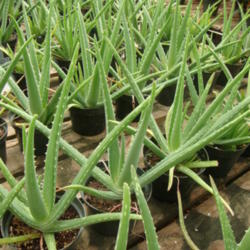Okay, enough time has passed. I would like to ask
@zuzu to weigh in on this.
Here's the situation: there are several aloes displayed under Aloe vera which are not the "true" Aloe vera, ie. they differ in several critical respects from the archetypal yellow-flowered species. Among those differences are floral features which are normally sufficient to define differences in species: the orange-flowered plants do not make ventricose flowers (ie. with a fat underbelly) and they make a flared opening that is not seen in the original. The racemes are shorter and less dense. These features are more consistent with a set of other aloes from the region, including and especially A. officinalis.
The CoL lists these plants as Aloe vera var. chinensis, as do older tags all over the place.
http://www.catalogueoflife.org...
The latest systematic reference on aloes (Aloes: The Definitive Guide, 2011) is unequivocal in placing A. v.c. under officinalis, providing the history and reasons.
You can read the story in the link I posted above but the bottom line is that A.v.c. was apparently popular in China (but has no origins in China) and is noted for medicinal properties comparable to A. vera. Presumably that made it a "true" aloe to somebody. Unfortunately (same article linked above) the medicinal effects are not the same, either.
Now quick story about Aloe officinalis. This plant is quite old; it was named for its medicinal effects in 1775. It is also an Arabian aloe and has also historically been subsumed as a variety of Aloe vera at various points in their collective history. However it is now regarded as its own species and has been found in the wild in Yemen, unlike Aloe vera. The floral differences noted above (and the lack of sterility) make this a much better match for A.v.c. (Interesting side note: there are yellow-flowered versions of officinalis, but those flowers differ from Aloe vera in the same ways the orange ones do. In other words, it's not so much the color, but the form which is distinctive.)
My preference with respect to the spotted aloes listed under Aloe vera in the database would be to move them to the generic Aloe listing, as I would not be comfortable assigning many of them a species designation without more info & flower pictures.

